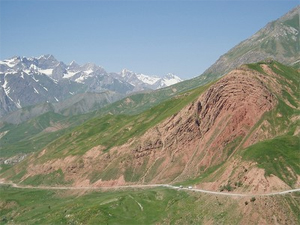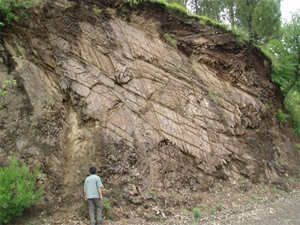
Lesson 3: Properties of Earth Materials
Rocks are forced to change shape at or near plate boundaries. Rocks can experience squeezing, stretching, or pushing in different directions in response to stress. This response depends on the type of stress, the rate at which it is applied, the environmental conditions of the rocks (such as temperature and pressure), and their composition. This lesson addresses the following questions: how do rocks deform; what factors play an important role in defining the behavior of rocks; what happens when rocks deform; and finally, why do rocks deform? Understanding the answers to these questions helps us better understand the physical processes that cause earthquakes.
This activity is designed for two one-hour class periods over two days, but it can also be done in one two-hour lab period.
Materials
- Small metal springs
- Rubber bands (cut in the middle to produce an elastic string)
- Silly putty (enough to be shared evenly among the students in the time allowed)
- Unbent paper clips, or pieces of metal wire
- Tootsie rolls (two pieces per student, refrigerated overnight)
- Photo 3a: ductile deformation of rocks
- Photo 3b: brittle deformation of rocks
To get the file for the photos, click here.
Introduction
2. Tell students that they are going to learn about some of the basic structural properties of materials. They are called "structural properties" because, for the purposes of this exercise, we are interested only in the ability of materials to hold shapes or move energy as if they were part of structures. Have students name some examples of simple and complex structures (e.g., tables, chairs, bridges, buildings). Tell them that our everyday experiences with different materials are very helpful for hypothesizing how materials will react when energy is applied to them in different ways. That is the basis for doing this exercise.
3. Explain to the students the meaning of the following words. Have students provide examples of materials that fit each description:
- Elastic: material that returns to its original shape after being deformed (i.e., rubber).
- Inelastic: material that does not return to its original shape after being deformed. There are two main subcategories of inelastic materials: brittle (material that cracks or fractures easily without much stretching, such as glass) and ductile (material that can be drawn, stretched, or compressed into a deformed shape without breaking, such as silly putty at room temperature).
4. Briefly explain what stress means: stress refers to the amount of force applied per unit area of material. Give them a simple example: when a person smashes an aluminum can using one foot, stress is being applied to the can. Explain what strain means: it refers to the change in shape of a material. A crushed can is strained in the above example. Therefore, stress causes strain.
Procedures

2. Divide the students into four groups and have them spend a few minutes at each area. Ask them to answer the following questions for each material:
- Is the material elastic or inelastic?
- If the object is inelastic, is the material brittle or ductile?
- What other materials are similar to this material? Does this object's material behave like the rocks that make up Earth's materials? Why or why not?
3. After everyone has had some time with each material, go over the students' responses and classify each material. The answers should be something like this:
- Rubber band: elastic
- Metal wires: inelastic, ductile
- Silly putty: inelastic, ductile (some may say brittle; see step 9)
- Metal springs: elastic (some may say ductile if the spring is stretched too far; see step 10)

Caution: Keep in mind that geologic structures may show evidence of more than one type of deformation.
5. Now tell students they are going to investigate how materials' properties can change according to environmental conditions. Distribute two cold tootsie roll candies to each student. Have the students speculate about what the properties of the candy are (i.e., elastic or inelastic, ductile or brittle). The cold tootsie roll should be inelastic and brittle. This can be demonstrated by hitting the candy sharply on the table — it should fracture into smaller pieces within the candy wrapper. Have the students try to deform the candy in different ways (e.g., stretching, compressing, bending), and explain that these are all examples of trying to get the candy to absorb energy.
6. Now, have the students warm the second piece of candy (i.e., by holding it between their hands, sitting on it, or putting it in their mouths). After the candies are made quite warm, have the students try to deform the candy in the same manner as was tried with the first candy. The candy should now be much more flexible, compressible, and stretchable than before. Some of the candies may still break, but the behavior will be quite different. The candy can be permanently deformed into a new shape without breaking with the addition of heat. You may ask the students to name other processes where this property is useful. Examples include metalworking, wherein iron, steel, or aluminum is heated so that it can be made into new shapes.
7. Describe that the same behavior happens for many types of rocks. Tell the students that temperature and pressure increase as one goes deeper in the Earth, so that the deeper Earth material (mantle rocks) are more easily described as an inelastic, ductile material than as elastic, brittle material, which crustal rocks seem to be. Below the Earth's surface, pressure prevents rocks from separating into fragments. In determining the transition from brittle to ductile behavior, temperature, pressure, deformation rate, and material composition are important.
Caution: Crustal rocks may exhibit ductile behavior under stress. Folding is one example. Pressure solution creep is a mechanism that can account for the ductility of crustal rocks at low temperatures and pressures. This process involves the dissolution of minerals in regions of high pressure and their precipitation in regions of low pressure. This results in creeping of rock. In addition, ductilely deformed rocks deeper in the Earth can be brought up to the Earth's surface by regional uplift and erosion.
8. Distribute the silly putty among students. Ask them to roll the silly putty into a small cylinder 5–10 centimeters long. Grabbing the cylinder with both hands (each at one end), ask them to quickly yank the silly putty in half so that it fractures cleanly in the middle. Now ask them to roll the silly putty back to its cylindrical shape, and with both hands (each at one end) pull it apart very slowly. Ask them what happens (with slow change in shape, it stretches and doesn't break). Ask the students if silly putty is elastic, inelastic, or both, and why. Encourage them to describe the conditions that lead to the behaviors they observed. Explain to the students that while the words we use (elastic, inelastic, etc.) describe behaviors of the materials, that all materials actually exhibit a mix of all properties depending on the conditions they experience.
9. To summarize the silly putty experiment, tell students the rate at which a material deforms dictates the behavior of the material. A sudden change in shape of rocks can cause brittle deformation (it can break the rocks) whereas a slow change in shape can cause ductile deformation (causing foliations in rocks).
10. Next, distribute the springs that were used in the first part of the exercise. Review that the spring appears to be an elastic material since it can be deformed and return to its original shape. Take the spring and stretch it to the point where it does not return to its original shape. It should be slightly longer than before but still retain its elastic properties. Recall that scientists say the object has been strained. Ask the students if this material is elastic, inelastic, or both? Why or why not? Under what conditions? Explain to the students that while the words we use (elastic, inelastic, etc.) describe behaviors of the materials, that all materials actually exhibit a mix of all properties depending on the conditions they experience.
11. Summarize all the above factors (temperature, pressure, deformation rate, and composition) that dictate the behavior of Earth's material.
12. Now distribute the rubber bands. Ask students to stretch the rubber bands. Ask them to predict what would happen if they let go of them (the rubber bands can fly a good distance and potentially harm someone). Ask them to explain why the stretched rubber band may pose a potential hazard (the potential energy stored in the stretched rubber band is released in the form of kinetic energy when released). Describe to the students that the Earth's crust can act like an elastic material and is capable of absorbing energy just like a rubber band. This stored energy can be released later (quickly or slowly) as earthquakes.
13. Finish the discussion by encouraging students to learn more about the causes of deformation and their relation to earthquakes in more depth in Lesson 4.
Further Exploration
Key Questions
Key Concepts

















